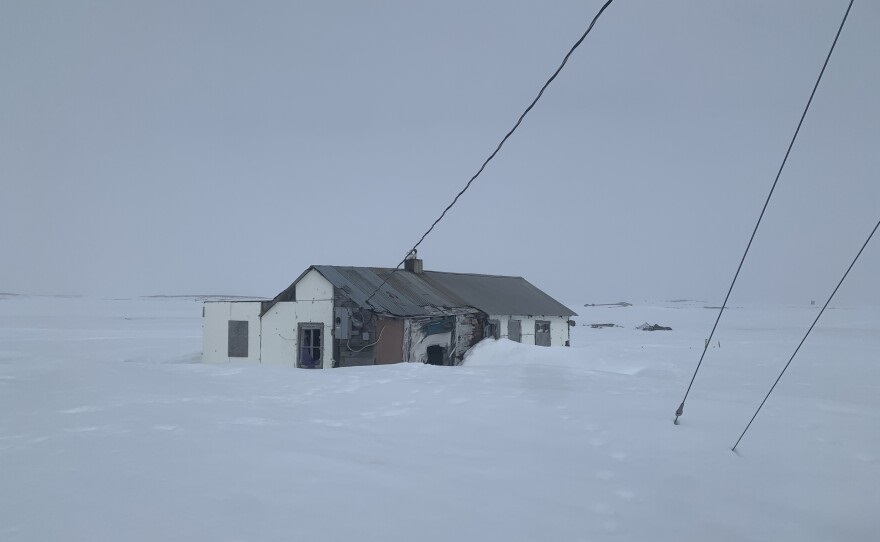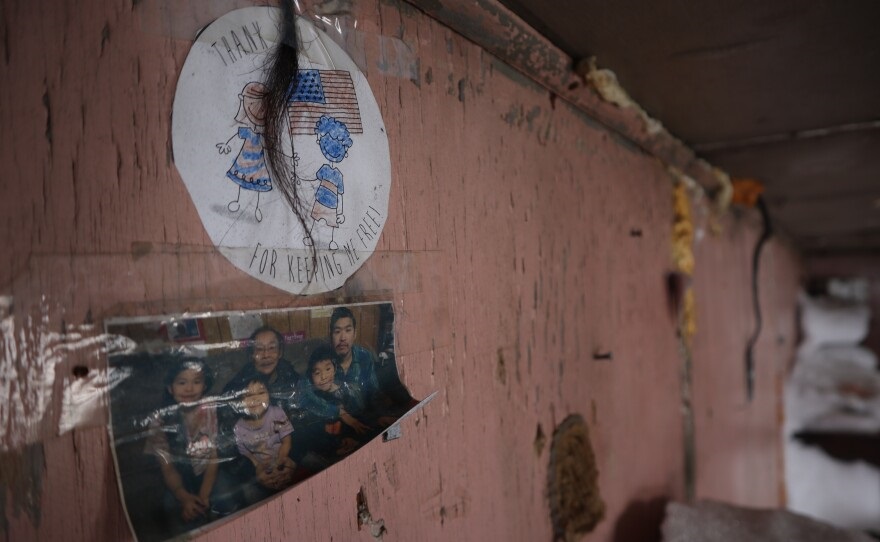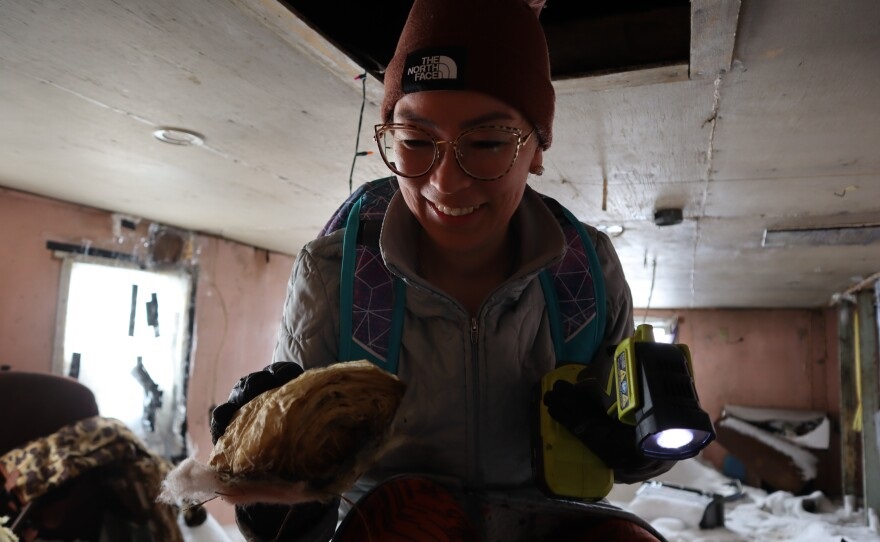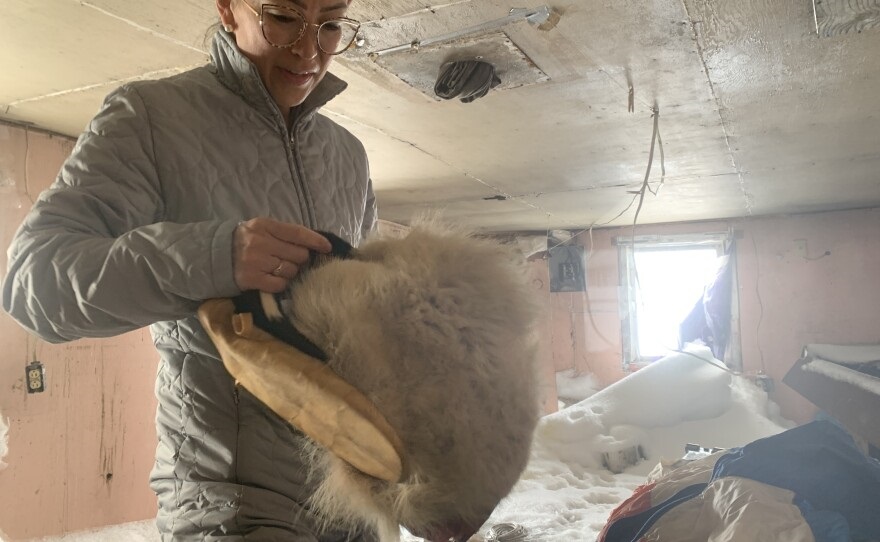Memories, stories and family heirlooms make the final move from Newtok
Description
 <figcaption class="wp-element-caption">A tiny, old, white house that sits along a slough from the Ningliq River is one of the first homes built in Newtok. It once belonged to Carolyn George’s grandmother, Betty Ann Tom Illanaq. (Emily Schwing/KYUK)</figcaption></figure>
<figcaption class="wp-element-caption">A tiny, old, white house that sits along a slough from the Ningliq River is one of the first homes built in Newtok. It once belonged to Carolyn George’s grandmother, Betty Ann Tom Illanaq. (Emily Schwing/KYUK)</figcaption></figure><figure class="wp-block-audio"></figure>
Residents in Newtok have been trying to move to higher, safer ground for more than three decades. By the end of November, that move may finally be complete. Nearly 90 people in the small Bering Sea coastal village are sifting through belongings to figure out what to take with them 9 miles across the Ningliq River to Mertarvik, a new townsite.
It’s easy to get caught up in the packing: kitchen utensils, clothes, and books, but there are other treasured belongings that also have to move. One day last April, Carolyn George found herself in an old house where her grandmother used to live. She was there to search through the musty, dark attic for a few treasured heirlooms.
“Yeah, we gotta take our whole life, our past,” George said as she tramped through knee-deep snow to get to the old house. “It’s right on the river, one of the first homes that was built when they first moved to Niuqtaq.”
<figure class="wp-block-image size-full">
 <figcaption class="wp-element-caption">There are signs everywhere that this house has been well loved. Family photos still hang on the walls, and a treasure trove of personal belongings is stashed in the attic. (Emily Schwing/KYUK)</figcaption></figure>
<figcaption class="wp-element-caption">There are signs everywhere that this house has been well loved. Family photos still hang on the walls, and a treasure trove of personal belongings is stashed in the attic. (Emily Schwing/KYUK)</figcaption></figure>Moving isn’t new for anyone who’s spent their life in Newtok. In the 1950s, George’s relatives came because the Bureau of Indian Affairs said that their old village – Kealivik – wasn’t a suitable spot to build a permanent public school. Now, this village has become unsuitable and they all have to move again. This time, it’s to Mertarvik, a new village site that sits high on a bluff overlooking the Ningliq River.
Once George reached her grandmother’s old house, she surveyed the scene. The house doesn’t have windows any more, and winter winds had blown snow inside. In places the snow had drifted halfway to the ceiling. Old photos are pinned to the plywood walls, and everyday items still line the bookshelves.
George climbed up on an old desk in the middle of what was once a living room. The top half of her body disappeared into a hole in the ceiling above: the attic. Then she started pulling things out and tossing them down on the floor below.
<figure class="wp-block-image size-full">
 <figcaption class="wp-element-caption">Carolyn George, who grew up in Newtok, was overjoyed to find two stretched and dried seal intestines hidden away in the attic of her grandmother’s old home. The material is naturally waterproof and was once used to make clothing, including raincoats, to protect against the harsh elements in this Bering Sea coastal village. (Emily Schwing/KYUK)</figcaption></figure>
<figcaption class="wp-element-caption">Carolyn George, who grew up in Newtok, was overjoyed to find two stretched and dried seal intestines hidden away in the attic of her grandmother’s old home. The material is naturally waterproof and was once used to make clothing, including raincoats, to protect against the harsh elements in this Bering Sea coastal village. (Emily Schwing/KYUK)</figcaption></figure>There’s a box of cassette tapes: Cat Stevens, the B-52s; there’s an old parka with a matted fur ruff.
Each item has a story: a private pilot’s airplane manual, a pair of fishing waders, old Christmas decorations – the kinds of things everyone’s grandma keeps in the attic.
As she worked, George reminisced. “I was so close to my grandma,” she said. She eventually named one of her five daughters for her grandmother, Betty Ann Tom Illanaq.
“She never criticized me, you know. She loved me and she would call for me every day,” George said. “She would even make excuses to have me come over. Like lying,” she said with a laugh. “She would say she had no more crackers, but my brother told me there were cases and cases in the shed.”
George was on a mission to find a few specific items in the attic of the old house. She pulled her legs up into the musty darkness and disappeared among bundles of grass used as insulation, old boxes, and bits and pieces of past lives. Finally, after about 20 minutes of rummaging, she found something.
“Look, it’s a seal intestine, rolled up!” George exclaimed.
<figure class="wp-block-image size-full">
 <figcaption class="wp-element-caption">In 2023, Carolyn George went rummaging around in her grandmother’s house and found a unique piliguq. In April, she returned to see if she could find its mate. The upper portions of these traditional, handmade boots are believed to be made from the skin and fur of a sled dog. (Emily Schwing/KYUK)</figcaption></figure>
<figcaption class="wp-element-caption">In 2023, Carolyn George went rummaging around in her grandmother’s house and found a unique piliguq. In April, she returned to see if she could find its mate. The upper portions of these traditional, handmade boots are believed to be made from the skin and fur of a sled dog. (Emily Schwing/KYUK)</figcaption></figure>George believed that her grandmother or her great-grandmother likely stretched and dried the intestine. The material is naturally waterproof material and in this village defined by windy, rainy weather, the papery, thin material is ideal for making things like raincoats.
A few minutes later, George found a second seal intestine. “Another one,” she called. It was folded neatly into a little square. “It could be a bag,” she said. Regardless, it’s a treasured find.
George was treasure hunting here late last winter when she made another intriguing find: a piliguq. Piluguqs are traditional footwear worn for celebrations and special events, including yuraq – Yup’ik dancing. Usually, they’re knee-high and made from seal or calf skin, but the one George found was different: thigh-high and trimmed in fur from a sled dog. She was looking for its mate.
<figure class="wp-block-image size-full"><img loading="lazy" decoding="async" width="880" height="542" src="https://media.alaskapublic.org/wp-content/uploads/2024/11/Newtok-Move-5.jpg" alt="a woman" class="wp-image-412780" srcset="https://media.alaskapublic.org/wp-content/uploads/2024/11/Newtok-Move-5.jpg 880w, https://media.alaskapublic.org/wp-content/uploads/2024/11/Newtok-Move-5-300x185.jpg 300w, https://media.alaskapublic.org/wp-content/uploads/2024/11/Newtok-Move-5-600x370.jpg 600w, https://media.alaskapublic.org/wp-content/uploads/2024/11/Newtok-Move-5-150x92.jpg 150w, https://media.alaskapublic.org/wp-content/uploads/2024/11/Newtok-Move-5-768x473.jpg 768w, https://media.alaskapublic.org/wp-content/uploads/2024/11/Newtok-Move-5-696x429.jpg 696w, https://media.alaskapublic.org/wp-




